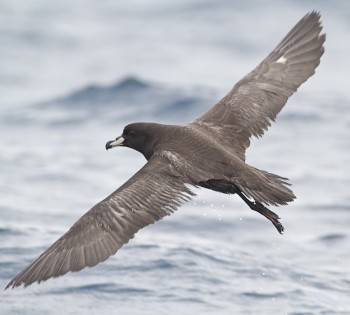Susan Waugh (Museum of New Zealand Te Papa Tongarewa, Wellington, New Zealand) and colleagues have published in the journal The Condor: Ornithological Applications on foraging patterns of the ACAP-listed and globally Endangered Westland Petrel Procellaria westlandica.
The paper’s abstract follows:
“Environmental and anthropogenic influences in the marine environment are primary drivers of behavior and demographic outcomes for marine birds. We examined factors influencing the foraging patterns of the Westland Petrel (Procellaria westlandica), a highly threatened, endemic petrel that inhabits subtropical water masses primarily in the Tasman Sea, with a poorly known at-sea distribution. Risk assessments place the species at moderate risk of population impacts from fisheries-related mortality. Studies in the 1990s indicated that trawl fisheries would have an important influence on the Westland Petrel's foraging behavior. We investigated the influence of climatic conditions, marine productivity, bathymetry, the core fishery zone, concurrent fishing activity, light conditions, sex, and breeding stage on Westland Petrel foraging patterns. We analyzed the stable isotopes of carbon and nitrogen from blood sampled during the incubation period and examined changes in isotopic niche width over a 6-yr period. We found that the Westland Petrel's foraging zone varied only slightly between years and that the location of intensively used areas was strongly influenced by bathymetric slope and latitude, and negatively influenced by chlorophyll-a. The core fishery zone had a secondary influence, suggesting that these petrels co-occur with fisheries, but are not dependent on waste for food. Trophic niche width was significantly wider during strong El Niño conditions, indicating that food type, rather than location, was most affected by climatic variation. Consistent use of one marine area across varying times and conditions increases the risk of adverse effects of climate or human-induced impacts on the species. However, marine spatial management tools become viable in these conditions. Further, with rapid increases in sea surface temperatures and extreme values recorded in the region in recent periods, changes to fisheries zones and distributions of natural prey of the species are likely to occur and may change the population's sustainability.”

Westlaand Petrel at sea, photograph by Raja Stephenson
Reference:
Waugh, S.M., Griffiths, J.W., Poupart, T.A., Filippi, D.P., Rogers, K. & Arnould, J.Y.P. 2018. Environmental factors and fisheries influence the foraging patterns of a subtropical seabird, the Westland Petrel (Procellaria westlandica), in the Tasman Sea. The Condor 120: 371-387.
John Cooper, ACAP Information Officer, 28 May 2018

 English
English  Français
Français  Español
Español